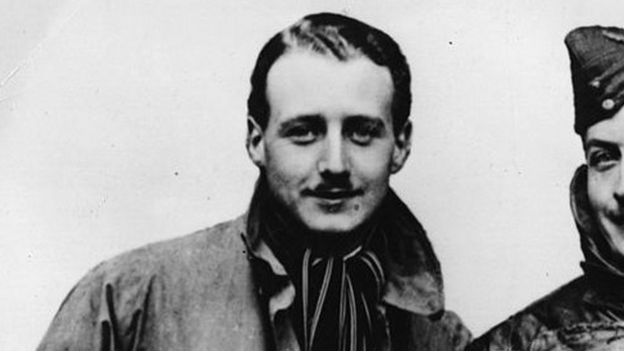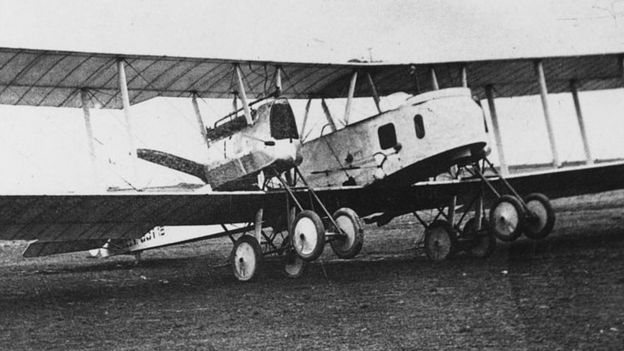An interesting article on the BBC news web site.
Dave.
http://www.bbc.co.uk/news/uk-england-tees-37164689
Leefe Robinson: The man who shot down a Baby Killer
By Duncan LeatherdaleBBC News
Share
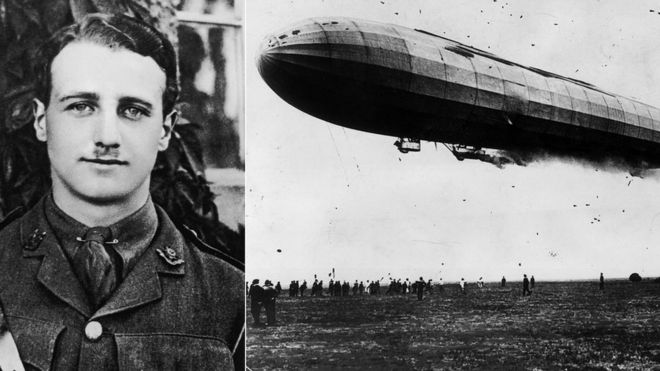 Image copyrightGETTY IMAGESImage captionLt William Leefe Robinson was the first person to shoot down a German airship over BritainOne hundred years ago, William Leefe Robinson became the first person to shoot down a German airship over the UK. The revolutionary bullets he used helped end the airship threat - but also led to people on the home front facing an even greater danger.
Image copyrightGETTY IMAGESImage captionLt William Leefe Robinson was the first person to shoot down a German airship over BritainOne hundred years ago, William Leefe Robinson became the first person to shoot down a German airship over the UK. The revolutionary bullets he used helped end the airship threat - but also led to people on the home front facing an even greater danger.
From their first use in January 1915, German airships became a greatly feared foe. Suddenly British civilians were on the front line for the first time and could be attacked from the air at seemingly any moment.
Flying at more than 10,000ft meant the airships' aim was abysmal, but in many ways that served only to heighten the fear of those on the ground - they really did not know where the bombs would fall.
The terror the airships induced was amplified by the fact conventional attempts to shoot them down typically failed.
Bullets could pierce the metal skin of the airships, but the Baby Killers - as the airships were nicknamed - were still able to fly back across the North Sea to their bases in north-west Germany.
All of this changed in the early hours of 3 September, 1916, when Lt William Leefe Robinson proved they could be destroyed.
Image copyrightGETTY IMAGESImage captionWilliam Leefe Robinson was flying a BE-2, similar to the aircraft pictured, on the night he shot down a German airshipThis success in the skies above London, which saw him awarded the Victoria Cross just 48 hours later, was due to a mixture of the 21-year-old's own bravery, an improved defence strategy and a revolutionary flammable bullet.
The new ammunition on board Robinson's BE-2 biplane was designed to ignite the hydrogen gas used to fill the 620ft-long (190m) long balloon.
Suddenly, the previously impregnable bombers were extremely vulnerable.
"Bullets up to that point were solid," said Alan Wakefield, head of World War One at the Imperial War Museum.
"They would do a lot of damage to a person but to an airship they would just punch small holes in this massive envelope of gas. Gas would leak but it would be very slow, you would need to make an awful lot of small holes to bring it down.
"The key was to make that hydrogen mix with oxygen which you could then ignite."
A brief history of airships
 Image copyrightGETTY IMAGESImage captionAirships had a tougher time once the British improved their defencesThere were two makes of airship used by the Germans to attack Britain during World War One.
Image copyrightGETTY IMAGESImage captionAirships had a tougher time once the British improved their defencesThere were two makes of airship used by the Germans to attack Britain during World War One.
The first and arguably most famous was the Zeppelin, a term which later became a catch-all for airships. This was named after the company's founder Count Ferdinand Von Zeppelin who developed the technology during the 1890s.
Then there was the Schütte-Lanz, which was less flammable and was designed after a Zeppelin caught fire in 1908.
The airships consisted of a gondola or carriage hanging below a large-gas-filled balloon propelled by an engine. They could reach speeds of 85mph (137km/h) and could carry several thousand pounds of bombs.
There were some 50 airship raids on Britain during WWI.
Though there was room on the gondolas, none of the crew had parachutes.
"They knew if something went wrong they would die," said Mr Wakefield. "One commander always took a revolver with him. He said he had no intention of jumping or burning to death."
The Lewis gun on Robinson's plane, which was fitted almost vertically to fire over the top wing, contained a mixture of two different types of bullets: Brocks and Buckinghams.
Named after their creators, the Brock contained potassium chlorate, a flammable liquid, while the Buckingham was filled with phosphorous to act as an incendiary.
Even armed with the new shells, Robinson's destruction of the Schütte-Lanz SL 11 required great personal skill.
It took him almost an hour to reach the 10,000ft (3km) where the airship, one of 16 raiding London and the south of England, was positioned.
Robinson, who was based at Sutton's Farm, later renamed RAF Hornchurch, used almost three magazines (each containing about 40 bullets) before he finally set the airship alight.
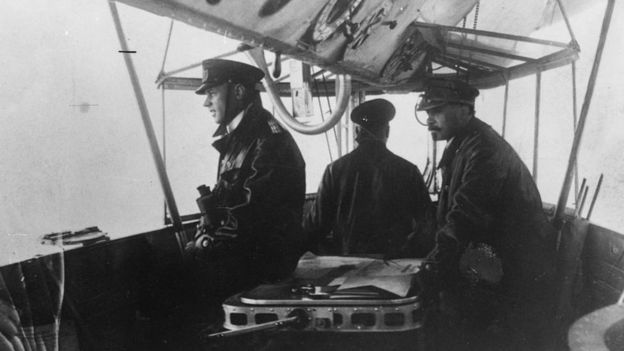 Image copyrightGETTY IMAGESImage captionThe airship crew, pictured here in 1916, operated the machine from a gondola suspended beneath the balloonTwice he attacked the sides to little effect before concentrating his fire on one spot at the rear.
Image copyrightGETTY IMAGESImage captionThe airship crew, pictured here in 1916, operated the machine from a gondola suspended beneath the balloonTwice he attacked the sides to little effect before concentrating his fire on one spot at the rear.
His attack was illuminated by search lights and witnessed by thousands of people on the ground.
Hundreds more visited the wreckage at Cuffley in Hertfordshire.
The pilot was hailed a hero, his was the fastest VC ever issued and the first awarded to someone for action in the UK.
The new found-fame did not sit well with the young man, however, and he asked to be sent to fly on the front-line.
How it felt to destroy an airship
Image copyrightGETTY IMAGESShortly after shooting down the airship Robinson, who was born in India and spent his childhood in Cumbria, wrote the following in a letter to his parents:
"When the colossal thing actually burst into flames it was a glorious sight. It literally lit up all the sky around and me as well of course - I saw my machine in the fire-light and sat still half-dazed staring at the wonderful sight before me.
"As I watched the huge mass gradually turn on end and, as it seemed to me, slowly sink, one glowing, blazing mass, I gradually realised what I had done and grew wild with excitement.
"When I reached the ground once more I was greeted with 'was it you Robin?'. 'Yes I've strafed the beggar this time', I said, whereupon the whole flight set up a yell and carried me out of my machine to the office, cheering like mad."
He was later told that the cheering from people in London could be heard up to 30 miles away, he wrote.
Source: Imperial War Museum
His first patrol on 5 April, 1917, ended with him being shot down in a dogfight in which the Germans were led by the feared Red Baron, Manfred von Richthofen.
Robinson spent the rest of the war in prisoner camps. His fame as the airship destroyer saw him treated particularly badly and, with his health weakened by punishments inflicted following several unsuccessful escape attempts, he finally succumbed to influenza on 31 December, 1918.
He was 23-years-old.
Other pilots were inspired by Robinson's feat and there followed a spate of them being brought down, for example in Hartlepool on 27 November 1916 by Ian Vernon Pyott.
"It was a great big thing, as long as the sky," said Violet Muers, who witnessed the attack as a young girl.
"Everybody was out in the street cheering because they'd got it, it was on fire - a great big light up in the sky."
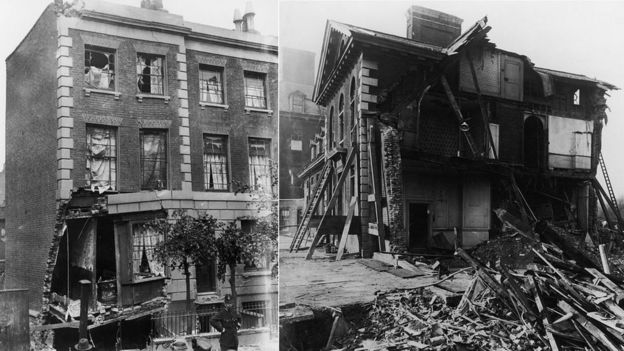 Image copyrightGETTY IMAGESImage captionThere were some 50 airship air-raids on Britain during World War OneThe success of the new technology was responsible for the German army withdrawing the use of airships in 1917 - by which time 77 out of 115 had been shot down or totally disabled.
Image copyrightGETTY IMAGESImage captionThere were some 50 airship air-raids on Britain during World War OneThe success of the new technology was responsible for the German army withdrawing the use of airships in 1917 - by which time 77 out of 115 had been shot down or totally disabled.
The sudden effective defence had two major consequences for the UK- one good, one bad.
"There's no question it boosted morale," said Mr Wakefield.
"It was amazing for people to see them being destroyed. Airships had basically had a year of attacking Britain with impunity. There did not seem to be a way to stop them, but now they were being downed, it's what people wanted to see.
"But it meant the Germans had to find a better way of attacking Britain. You could say it inspired them to develop a more effective attack weapon much more quickly."
Image copyrightGETTY IMAGESImage captionThe successful efforts of men like William Leefe Robinson and Ian Vernon Pyott proved the airships were not invulnerableImage copyrightGETYImage captionGotha bombers raided London 27 times during World War OneThe new weapon was the Gotha bomber - which could bomb its targets far more accurately.
Airships killed almost 560 people and injured a further 1,358 in about 50 raids. The Gothas killed more than 800 and injured almost 2,000 in half as many attacks.
"The offence does something, the defence finds a way to beat it, the offence comes up with something new," said Mr Wakefield.
"The Germans knew who Robinson was when they caught him and he was treated much worse because of that.
"And Britain had to contend with an even worse weapon than the airship. That's how the arms race works."
Dave.
http://www.bbc.co.uk/news/uk-england-tees-37164689
Leefe Robinson: The man who shot down a Baby Killer
By Duncan LeatherdaleBBC News
- 6 hours ago
- From the sectionTees
Share

From their first use in January 1915, German airships became a greatly feared foe. Suddenly British civilians were on the front line for the first time and could be attacked from the air at seemingly any moment.
Flying at more than 10,000ft meant the airships' aim was abysmal, but in many ways that served only to heighten the fear of those on the ground - they really did not know where the bombs would fall.
The terror the airships induced was amplified by the fact conventional attempts to shoot them down typically failed.
Bullets could pierce the metal skin of the airships, but the Baby Killers - as the airships were nicknamed - were still able to fly back across the North Sea to their bases in north-west Germany.
All of this changed in the early hours of 3 September, 1916, when Lt William Leefe Robinson proved they could be destroyed.
Image copyrightGETTY IMAGESImage captionWilliam Leefe Robinson was flying a BE-2, similar to the aircraft pictured, on the night he shot down a German airshipThis success in the skies above London, which saw him awarded the Victoria Cross just 48 hours later, was due to a mixture of the 21-year-old's own bravery, an improved defence strategy and a revolutionary flammable bullet.
The new ammunition on board Robinson's BE-2 biplane was designed to ignite the hydrogen gas used to fill the 620ft-long (190m) long balloon.
Suddenly, the previously impregnable bombers were extremely vulnerable.
"Bullets up to that point were solid," said Alan Wakefield, head of World War One at the Imperial War Museum.
"They would do a lot of damage to a person but to an airship they would just punch small holes in this massive envelope of gas. Gas would leak but it would be very slow, you would need to make an awful lot of small holes to bring it down.
"The key was to make that hydrogen mix with oxygen which you could then ignite."
A brief history of airships

The first and arguably most famous was the Zeppelin, a term which later became a catch-all for airships. This was named after the company's founder Count Ferdinand Von Zeppelin who developed the technology during the 1890s.
Then there was the Schütte-Lanz, which was less flammable and was designed after a Zeppelin caught fire in 1908.
The airships consisted of a gondola or carriage hanging below a large-gas-filled balloon propelled by an engine. They could reach speeds of 85mph (137km/h) and could carry several thousand pounds of bombs.
There were some 50 airship raids on Britain during WWI.
Though there was room on the gondolas, none of the crew had parachutes.
"They knew if something went wrong they would die," said Mr Wakefield. "One commander always took a revolver with him. He said he had no intention of jumping or burning to death."
The Lewis gun on Robinson's plane, which was fitted almost vertically to fire over the top wing, contained a mixture of two different types of bullets: Brocks and Buckinghams.
Named after their creators, the Brock contained potassium chlorate, a flammable liquid, while the Buckingham was filled with phosphorous to act as an incendiary.
Even armed with the new shells, Robinson's destruction of the Schütte-Lanz SL 11 required great personal skill.
It took him almost an hour to reach the 10,000ft (3km) where the airship, one of 16 raiding London and the south of England, was positioned.
Robinson, who was based at Sutton's Farm, later renamed RAF Hornchurch, used almost three magazines (each containing about 40 bullets) before he finally set the airship alight.

His attack was illuminated by search lights and witnessed by thousands of people on the ground.
Hundreds more visited the wreckage at Cuffley in Hertfordshire.
The pilot was hailed a hero, his was the fastest VC ever issued and the first awarded to someone for action in the UK.
The new found-fame did not sit well with the young man, however, and he asked to be sent to fly on the front-line.
How it felt to destroy an airship
Image copyrightGETTY IMAGESShortly after shooting down the airship Robinson, who was born in India and spent his childhood in Cumbria, wrote the following in a letter to his parents:
"When the colossal thing actually burst into flames it was a glorious sight. It literally lit up all the sky around and me as well of course - I saw my machine in the fire-light and sat still half-dazed staring at the wonderful sight before me.
"As I watched the huge mass gradually turn on end and, as it seemed to me, slowly sink, one glowing, blazing mass, I gradually realised what I had done and grew wild with excitement.
"When I reached the ground once more I was greeted with 'was it you Robin?'. 'Yes I've strafed the beggar this time', I said, whereupon the whole flight set up a yell and carried me out of my machine to the office, cheering like mad."
He was later told that the cheering from people in London could be heard up to 30 miles away, he wrote.
Source: Imperial War Museum
His first patrol on 5 April, 1917, ended with him being shot down in a dogfight in which the Germans were led by the feared Red Baron, Manfred von Richthofen.
Robinson spent the rest of the war in prisoner camps. His fame as the airship destroyer saw him treated particularly badly and, with his health weakened by punishments inflicted following several unsuccessful escape attempts, he finally succumbed to influenza on 31 December, 1918.
He was 23-years-old.
Other pilots were inspired by Robinson's feat and there followed a spate of them being brought down, for example in Hartlepool on 27 November 1916 by Ian Vernon Pyott.
"It was a great big thing, as long as the sky," said Violet Muers, who witnessed the attack as a young girl.
"Everybody was out in the street cheering because they'd got it, it was on fire - a great big light up in the sky."

The sudden effective defence had two major consequences for the UK- one good, one bad.
"There's no question it boosted morale," said Mr Wakefield.
"It was amazing for people to see them being destroyed. Airships had basically had a year of attacking Britain with impunity. There did not seem to be a way to stop them, but now they were being downed, it's what people wanted to see.
"But it meant the Germans had to find a better way of attacking Britain. You could say it inspired them to develop a more effective attack weapon much more quickly."
Image copyrightGETTY IMAGESImage captionThe successful efforts of men like William Leefe Robinson and Ian Vernon Pyott proved the airships were not invulnerableImage copyrightGETYImage captionGotha bombers raided London 27 times during World War OneThe new weapon was the Gotha bomber - which could bomb its targets far more accurately.
Airships killed almost 560 people and injured a further 1,358 in about 50 raids. The Gothas killed more than 800 and injured almost 2,000 in half as many attacks.
"The offence does something, the defence finds a way to beat it, the offence comes up with something new," said Mr Wakefield.
"The Germans knew who Robinson was when they caught him and he was treated much worse because of that.
"And Britain had to contend with an even worse weapon than the airship. That's how the arms race works."


